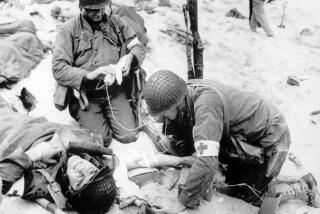A storied history nears end for Walter Reed hospital
- Share via
Reporting from Washington — Outside the 113-acre complex at Walter Reed Army Medical Center stood a wounded soldier ready to run — on one leg. With a blade and spring in place of his amputated limb, he sprinted up and down the veranda, unrestrained.
The moment reflected much of what workers and patients at Walter Reed, the Army’s flagship hospital, have come to revere about the 102-year-old facility that will shut down and move its operations to Bethesda, Md., in the coming weeks.
“Here’s a guy who lost a leg and is doing everything he can to get back to what he was before,” said John Pierce, a physician who worked at Walter Reed for 15 years. “I’m gonna remember these young folks who are just so resilient.”
Named after an Army physician who proved that yellow fever was transmitted by mosquitoes and not by direct contact with the infected or their clothing, the facility has treated hundreds of thousands of patients since it opened in 1909, including presidents and generals.
Presidents Harry S. Truman and Dwight D. Eisenhower paid their respects to the hospital. Eisenhower died there in 1969. Gen. Douglas MacArthur and Gen. George Marshall visited as well.
Perhaps most notably, Richard Nixon received treatment at the hospital during the 1960 presidential campaign. After bumping his knee against a car, Nixon received intravenous antibiotic treatment for an infected joint, according to Pierce, historian of the Walter Reed Society.
Against the advice of Walter Reed doctors, a determined Nixon decided to appear on television for the first presidential debate against John F. Kennedy, Pierce said. Viewers thought Kennedy came across as more lively and vigorous — something political scientists have noted may have influenced the election’s outcome.
Because of its storied history and the presidential aura surrounding the facility, Walter Reed is known throughout the world of military medicine.
“If you go any place in the world, and you speak to people who are in the military, even people who can’t speak English, and you say the words ‘Walter Reed,’ that’s all you need to say because they instantly understand what you’re talking about,” said Col. Norvell Coots, commander of the Walter Reed Healthcare System.
The idealized portrayal of the hospital was tainted in 2007. After a series of Washington Post articles exposed administrative neglect at the facility, Walter Reed suffered a lasting blow to its image as a center of scientific and medical innovation.
People who worked there maintain that the medical care delivered to soldiers was always kept up to par, though they acknowledge the frustration experienced by many patients who endured inadequate housing and had difficulty processing out of the service.
The surge of wounded soldiers coming home from the wars in Afghanistan and Iraq proved too much for the hospital to handle at times. Pierce said that the number of soldiers in the Walter Reed medical holding company, which provides administrative support, went from 100 in 1998 to 900 by 2007.
“There were just situations where family members weren’t treated the way they should have been considering the emotional stress that they must be under,” said Peggy Baker, director of Operation First Response, a charity that’s helped more than 7,000 soldiers, many of whom passed through Walter Reed.
Former workers insist, however, that Walter Reed has gotten a fresh start. The heads of the hospital resigned amid the scandal, and a colonel replaced a captain who was in charge of the medical holding company, Pierce said.
Current employees are still sensitive about the subject. When a reporter tried to pose a question about the investigation to an employee who has worked at Walter Reed for 40 years, a hospital spokesman interrupted the interview.
Nevertheless, today’s wounded soldiers seem to trust the institution and refer to it as a second home.
“Walter Reed has sort of been like a safe place for soldiers for so long,” said Sgt. Sean Patterson, whose buddies were treated there for wounds they sustained in Iraq in 2003. “When the worst that can possibly happen to a soldier happens, Walter Reed is the place that a soldier goes for the best that can happen to a soldier. So seeing this close is — it’s an end of an era.”
Some of the 72 buildings at the site will be turned over Sept. 15 to the District of Columbia for its reuse commission to consider, and others will go to the State Department, Coots said. But the name will live on in Bethesda, where the new facility has 1 million square feet of clinical space and will be called the Walter Reed National Military Medical Center.
More to Read
Sign up for Essential California
The most important California stories and recommendations in your inbox every morning.
You may occasionally receive promotional content from the Los Angeles Times.










